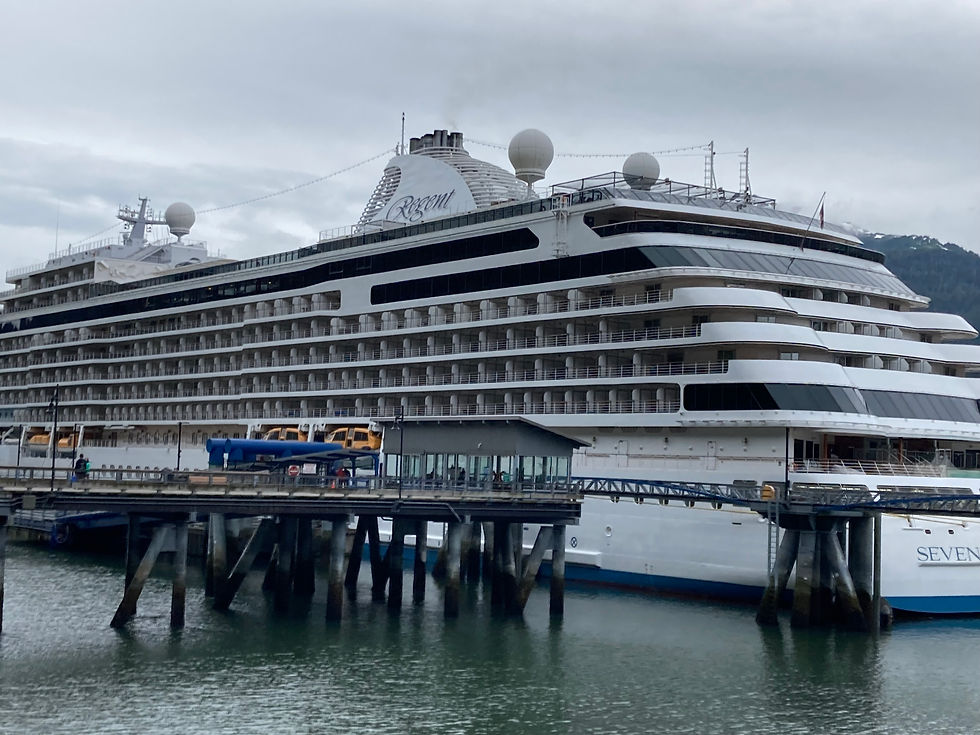Hazard Pay
- stellahdawson
- Jun 30, 2024
- 3 min read

Google “hazards” and “Juneau” and you'll find listed avalanches, earthquakes, tsunamis, landslides and floods, all acts of nature to be expected for a region that in geological terms is highly active and relatively new.
Ships or attacks from wildlife scarcely figure.
There are no snakes, skunks, ticks or chiggers here. Wolves are better known for befriending people and their (big) dogs in Juneau. The wolf Romeo who frequented Mendenhall Glacier from 2003 to 2009 was so beloved there is a plaque to him in the Tongass National Forest and an opera was performed.

Romeo greets a canine friend (Photo from Dan's Pet Care)
Bears don’t even make the list of hazards, neither the plentiful black ones nor the brown, even though we religiously carry bear spray on all our hikes. No human attacks recorded in Juneau. And moose are too few in number to be of concern.
In Southeast Alaska, the Pacific tectonic plate is grinding northward and westward against the more buoyant continental rock of the North American plate at the rate of a couple of inches each year. In the process, it is shearing and tugging the whole region westward. Well-developed faults, active for tens of million of years, produce shallow tremblors that over millenia have built the dramatic Coastal Range, the deep fjords, rivers and glaciers that make for the magnificence of this area. Throughout the state, more than 20,000 earthquakes are recorded on average each year, one of the most active regions in the world, with the central and western regions the most prolific. Earthquakes are responsible for triggering the avalanches, landslides and tsunamis. The floods mostly are from glacial melt.
Notably missing from the list of hazards in Juneau are the cruise ships.
From mid April to early October, five of these massive floating cities dock in Juneau every day.

And this one is smaller than some
The main street in downtown swarms with 15,000 people from morning until the cruise ships lift anchor at night and head for the next stop. The city recently capped the total number of ships and guests that can visit per day, it was getting so overwhelmed, and there’s an active campaign for Ship-Free Saturdays. Apart from jammed-up traffic and overflowing sidewalks, the cruise ships have been known to hit whales, especially in the fall when fog descends on the channel. Tango, a calf born to Flame, a superstar mom who is a local favorite of the Alaska whale-watching community, died last year of a vessel strike.
What no one talks about, however, is the viruses the cruise ships bring.
These ships are floating cesspools that descend on the city, crowd into our buses and boats and shower us with their sicknesses. I am on my second heavy-duty cold, with the full panoply of glorious symptoms, in three weeks. Both have laid me out flat for days at a time. Captain Michelle, my housemate, had a boy on her boat projectile vomiting repeatedly, despite glass-calm waters, and now she is developing symptoms for her third assault. We pass the viruses from guide to guide to captain to driver, and the daily scheduler at Gastineau Guiding is regularly seeking volunteers to cover for those who
have called out sick.
But no one will talk about it. Is this normal? No one likes to admit, but I deduce the answer is a resounding, “Yes.” A gentle irony that my summer in the great outdoors would have me sicker than a five-year-old fresh into kindergarten.
Hazard pay, anyone?
Footnotes:
More about Romeo in this blog post https://danspetcare.com/pets/romeo
Flame, the superstar whale https://www.fisheries.noaa.gov/feature-story/flame-juneau-alaskas-wildlife-superstar
Earthquake information in Alaska https://earthquake.alaska.edu/earthquakes/about










コメント